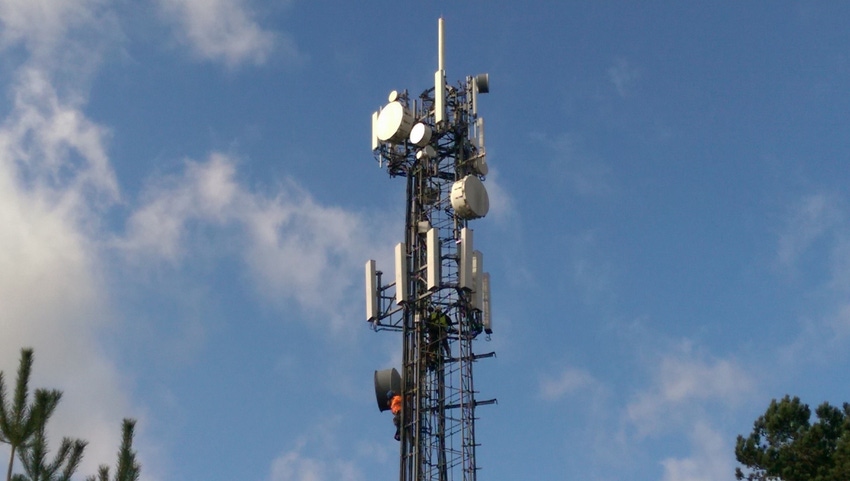The technology in a radio tower is undergoing dramatic change, which is presenting tough real-world challenges for the crews that carry out work.
June 20, 2017

Telecoms.com periodically invites expert third parties to share their views on the industry’s most pressing issues. In this piece Kashif Hussain, CellAdvisor Solutions Marketing from Viavi Solutions, explains how the technology in a radio network tower is undergoing dramatic change, presenting tough real-world challenges for the maintenance crews.
The technology in a radio tower is undergoing dramatic change, which is presenting tough real-world challenges for the crews that carry out work. Riggers, or tower climbers as they’re better known in the US, are finding that as networks today become more complex, their role is becoming increasingly difficult to conduct.
As technicians, riggers perform installations, inspections and repairs on towers, often involving tower climbs with test equipment in dangerous circumstances. In a new survey, Viavi Solutions revealed that 67% of riggers in the UK, and 88% in the US, believe that their job is becoming more complex. Viavi spoke to this elite community to get a feel for the challenges faced and how Viavi, and other network equipment manufacturers, could help tackle these head on.
The safety challenge
The Head of the Occupational Safety and Health Administration (OSHA) once called the role of the rigger “the most dangerous job in America” – which entirely justifies the claim that, in many ways, riggers are the unsung heroes of the telecoms world.
Viavi found that 44% of the UK riggers surveyed think it has become fairly costly, complex and dangerous to carry out testing at the top of the tower. This comes as little surprise, as much of the job of a rigger is conducted at great heights where there is a risk of injury from falls.
Reducing the number of fatalities and improving the safety of riggers is vital and efforts are being made to place it firmly on the industry agenda. In June 2017, the FCC and OSHA teamed up to release new guidance and best practices to improve the safety conditions and to call for a safer environment for riggers. With deaths occurring each year, there is a responsibility on the industry to focus on ways to reduce the dangerous reality of a rigger’s job.
Weighed down with cumbersome equipment
In addition to climbing to great heights, riggers are weighed down by the advanced technical test equipment that must be carried to the top of the tower. This is in addition to other physical tools needed for their job such as spanners, wrenches and hammers.
Almost half (42%) of those surveyed based in the UK stated that lighter, easier to use equipment would make tower climbs less cumbersome. Riggers perform multiple tasks during tower climbs, so it is no wonder that more than three quarters said they now need between 20 to 50 per cent more time at each site to carry out required maintenance work.
Along with lighter, easier to carry equipment, 18% of UK riggers also said they would benefit from equipment that performs multiple tests simultaneously. This would, of course, further reduce the amount of heavy equipment that needs to be taken up the tower. Also on the wish list of riggers was access to good, easy to use test equipment and access to reports that are easily and readily available.
Why is the role of the rigger becoming more complex?
Up until recently, much of the real radio equipment at a network cell tower was safely and conveniently stored in a cabinet on the ground or near to the base of the site. A coaxial cable connected the radio gear to the antennae at the top of the tower. This meant that a rigger could check the quality of an RF signal being received in the cabinet, without the need to climb a tower.
But today, a distributed architecture in modern cell sites means that fibre is frequently used to connect RE equipment stored in a Remote Radio Head (RRH) at the top of the tower, to the other radio heads and the Radio Equipment Control (REC) gear in the Baseband Unit (BBU) at the foot of the towers. The reason for the switch is that fibre link offers a boost to signal quality and improved performance – but at the expense of the rigger of course.
With all RF functions for each tower at the RHH, interference analysis needs to be taken at the top of the tower. This has led to a greater security risk for riggers who must perform interference analysis, as well as higher operational costs.
A solution to the challenges
Common Public Radio Interface (CPRI) – the specification for the communication between BBU and RHH – has become the industry standard for the internal interface between cell towers in a distributed architecture.
Being able to analyse RF performance of multiple RHHs from BBUs is a significant step that can increase maintenance efficiency and reduce the number of tower climbs necessary. This is done by utilizing RFoCPRI technology.
Base station analysers that support RFoCPRI technology at the BBU, are helping riggers to access RF signals and the spectrum from the bottom of the base station, without the need for tower climbs. This means they can test for RF interference without disrupting customer service, by allowing RF maintenance and troubleshooting activities to be performed via the fibre interfaces at the BBU.
These modern analysers have been hailed as a breakthrough because riggers can identify which tower being served by the BBU has an interference issue. Tower climbs can be targeted to those sites with likely issues at the RHH level, removing the guess work from fibre testing.
Advances in technology are helping riggers to overcome the fierce challenges that have, until now, been part and parcel of their job. The latest generation of RFoCPRI analysers are reducing the number of tower climbs necessary, which will no doubt make the role of the rigger much safer. The ability to perform multiple tests with one piece of handy kit is making their role easier and means that the time spent on site is reduced, driving greater efficiency.
With such a vital job to do, it’s crucial that the breakthroughs in RFoCPRI technology continue to ensure the work of a rigger is easy, efficient, and most importantly, safe.
 Kashif Hussain is the CellAdvisor Solutions Marketing at Viavi Solutions (formerly JDSU) for the wireless business unit. He has more than 20 years of wireless industry experience. Kashif’s expertise in RF, DAS, HetNets, and LTE comes from developing, managing, supporting, marketing and consulting on major mobile communications projects. Kashif’s industry experience also includes various senior roles at MobileNet, Tektronix Communications, Ericsson and Nortel. He has also authored patent for wireless products.
Kashif Hussain is the CellAdvisor Solutions Marketing at Viavi Solutions (formerly JDSU) for the wireless business unit. He has more than 20 years of wireless industry experience. Kashif’s expertise in RF, DAS, HetNets, and LTE comes from developing, managing, supporting, marketing and consulting on major mobile communications projects. Kashif’s industry experience also includes various senior roles at MobileNet, Tektronix Communications, Ericsson and Nortel. He has also authored patent for wireless products.
Read more about:
DiscussionAbout the Author(s)
You May Also Like








.png?width=300&auto=webp&quality=80&disable=upscale)


_1.jpg?width=300&auto=webp&quality=80&disable=upscale)


.png?width=800&auto=webp&quality=80&disable=upscale)